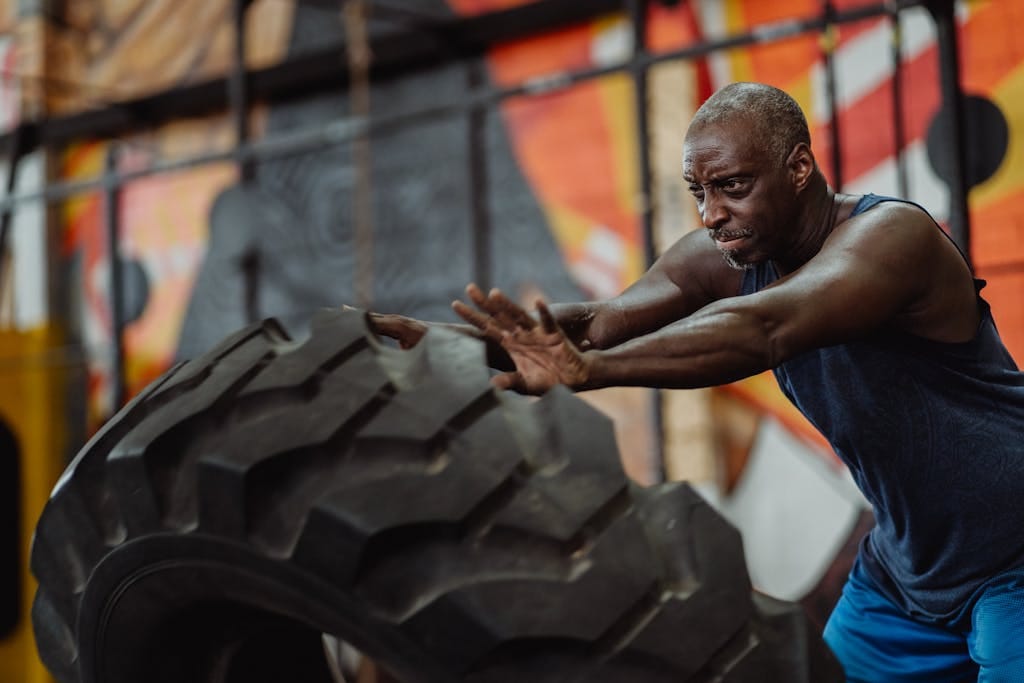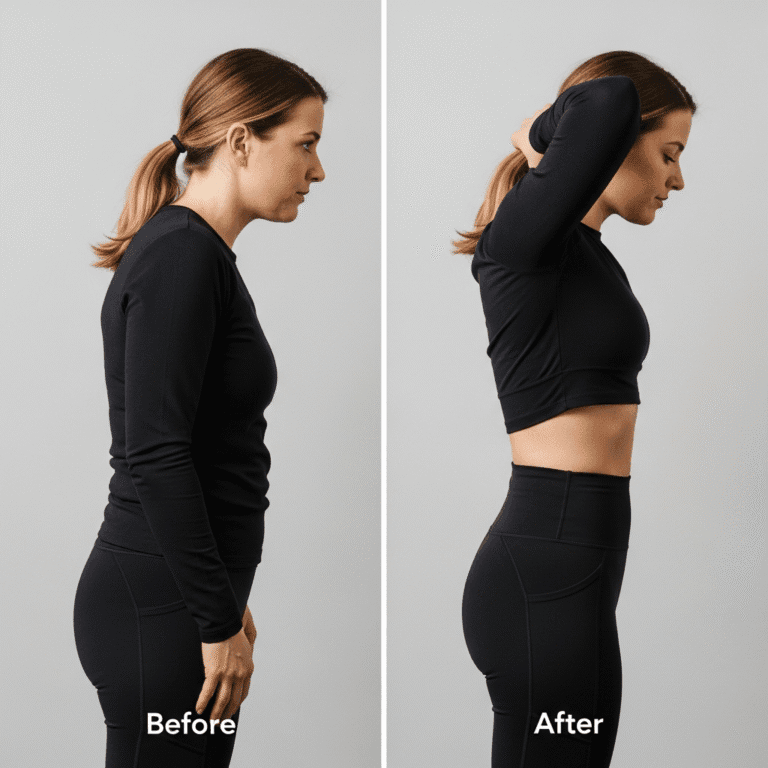FREE SHIPPING OVER $50
Over 40? Trainers Say These 6 Exercises Are Non-Negotiable for Strength and Longevity

Forget the endless, low-impact cardio or the isolation machines that only target one muscle group. If you are over 40 and your goal is to maintain robust strength, stave off age-related muscle loss (sarcopenia), boost your metabolism, and keep your body resilient for decades to come, you need to focus on what the experts call the Foundational Six.
Personal trainers and longevity specialists worldwide consistently agree that these six crucial movements are non-negotiable. They are compound exercises that recruit the maximum amount of muscle, provide the biggest hormonal boost, and translate directly to real-world, functional power—the kind that makes hauling groceries or playing with your grandkids easy, not painful.
The Foundational Six: Essential Lifts for the Over-40 Man
The key to maximizing your effort after 40 lies in compound lifts. These multi-joint exercises work several muscle groups simultaneously, giving you more bang for your buck and stimulating the hormonal response necessary for muscle maintenance and bone density.
1. The Squat (The King of Lower Body Power)
When personal trainers talk about non-negotiable movements, the squat always tops the list. Squatting is arguably the most fundamental human pattern; you perform a version of it every time you sit down and stand up.
Why the Squat is Non-Negotiable
As you age, lower body strength is directly linked to longevity and independence. Consistent squatting dramatically improves mobility, stability, and balance, which drastically reduces the risk of falls later in life. Furthermore, since the legs contain the largest muscle groups in the body (quadriceps, hamstrings, and glutes), executing heavy squats provides an intense metabolic stimulus that helps keep your body fat in check and supports healthy hormone levels.
Optimizing Your Squat After 40
- Prioritize Depth and Form: Focus on reaching parallel or slightly below, but only within a comfortable range. Start with bodyweight movements or a goblet squat (holding a dumbbell vertically against your chest) to master the hip-hinge pattern before adding a heavy barbell. This technique keeps the load away from the spine as you refine the movement.
- Keep Your Chest Up: Drive your knees slightly outward and maintain a proud, upright chest. This ensures proper core engagement and helps protect your lower back from unnecessary strain.
- The Power is in the Hips: When standing up, think about forcefully driving your hips forward and up out of the bottom position, rather than simply straightening your knees. This recruits the powerful gluteal muscles.
2. The Deadlift (The Ultimate Full-Body Resilience Builder)
The deadlift is the exercise that works nearly every single muscle in your body, from your grip and forearms to your upper back, core, glutes, and hamstrings. It’s literally the act of picking a heavy object up off the floor—the supreme test of real-world strength.
Why the Deadlift is Non-Negotiable
This lift is unmatched for strengthening the posterior chain (the muscles along the back of your body), which is crucial for good posture and counteracting the damage caused by prolonged sitting. A weak posterior chain is a primary culprit for chronic lower back pain in men over 40. The deadlift strengthens your core and lower back musculature, effectively acting as a suit of armor against everyday strains. Like the squat, it’s a powerful driver of bone mineral density in the spine and hips, significantly mitigating the risk of osteoporosis.
Optimizing Your Deadlift After 40
The deadlift demands respect and perfect technique to be effective and safe.
- The Trap Bar Advantage: For most men over 40, the trap bar deadlift is a safer and often superior option. It centers the weight, places less sheer force on the lumbar spine, and allows for a more upright torso position, which is kinder to aging hips and shoulders.
- Hinge, Not Squat: Ensure you are hinging at the hips (pushing your butt back) to initiate the movement, rather than squatting the weight up. The bar should remain in contact with or very close to your body throughout the lift.
- Brace Your Core: Before you lift, take a deep, powerful breath into your belly and brace your core as if preparing to take a punch. This abdominal rigidity is key to spinal protection.
3. The Overhead Press (Shoulder Health and Vertical Power)
The overhead press (or military press) is the foundational movement for upper body vertical strength. It requires you to stabilize and drive a weight straight above your head, a motion that powerfully engages the shoulders, triceps, and, most importantly, the entire core and upper back stabilizing musculature.
Why the Press is Non-Negotiable
As we age, our shoulders are prone to injury and loss of mobility due to poor posture and desk work. Regularly pressing weight overhead—with controlled, strict form—is a fantastic way to maintain shoulder health by strengthening the rotator cuff and all the small muscles that hold the shoulder capsule together. This exercise also demands a rigid, standing position, which enhances core stability under load, a vital element of overall functional fitness.
Optimizing Your Press After 40
- Use Dumbbells: If you experience any shoulder discomfort with a straight barbell, switch to a seated or standing dumbbell press. Dumbbells allow your hands to rotate slightly inward (a more natural path for the shoulder joint), significantly reducing stress on the rotator cuff and allowing you to train around minor mobility issues.
- Elbow Position: Keep your elbows slightly forward, not flared out directly to the sides. This ensures you are pressing in the scapular plane, which is the safest path for the shoulder joint.
- Finish Strong: Push your head “through” the imaginary slot once the weight passes your forehead, ensuring the load finishes directly over your shoulders and hips.
4. The Pull-Up or Lat Pulldown (Back Width and Postural Correction)
You must balance pushing movements (like the overhead press or bench press) with pulling movements. The pull-up is the undisputed king of all vertical pulling exercises.
Why the Pull-Up is Non-Negotiable
The sheer effort of the pull-up builds a wide, strong back—specifically the latissimus dorsi—which is the primary muscle responsible for improving your posture. Pulling exercises actively combat the hunched-over posture caused by modern life, pulling your shoulders back and down. They are also unparalleled for building grip strength, which studies have repeatedly linked to overall longevity and health status. If you can’t manage a full pull-up yet, the movement pattern is still non-negotiable.
Optimizing Your Pulling After 40
- The Lat Pulldown Substitution: If you can’t complete a full, strict pull-up, immediately substitute it with the lat pulldown machine. Focus on pulling the bar to your upper chest using your back muscles, not just your arms. Maintain a slight lean back to fully engage the lats.
- Assisted Variations: Utilize an assisted machine or heavy resistance bands looped over the bar to build the necessary strength and endurance. Work toward achieving a few full-range repetitions without assistance.
- Dead Hangs: Simply holding onto the pull-up bar for time is a powerful way to build grip strength and gently decompress the spine, a welcome benefit for the aging back. Aim to accumulate 60 to 90 seconds of total hang time over several sets.
5. The Dumbbell Row (Unilateral Strength and Core Stability)
While the deadlift and pull-up cover the posterior chain and vertical pull, you need a heavy horizontal pull to fully strengthen your mid-back and correct potential muscle imbalances. The single-arm dumbbell row is arguably the most scalable and beneficial exercise for this.
Why the Dumbbell Row is Non-Negotiable
This exercise forces each side of your body to work independently (unilaterally), exposing and correcting side-to-side strength imbalances that often lead to injury. When you plant one knee and one hand on a bench and pull a heavy dumbbell toward your hip, you fiercely engage your deep core stabilizers and the muscles around your spine to prevent your torso from rotating. This anti-rotational stability is critical for preventing injury during dynamic activities like sports or simply lifting a heavy object awkwardly.
Optimizing Your Row After 40
- Focus on the Squeeze: Don’t just yank the weight up with your biceps; pull your elbow back and squeeze your shoulder blade toward your spine at the peak of the movement. Your back muscles should initiate the action.
- Go Heavy (but Controlled): This is one exercise where you can safely load significant weight, but always maintain a slow, controlled negative (lowering) phase to maximize muscle time under tension and growth.
- Anti-Rotation is Key: Keep your hips and shoulders square to the floor throughout the movement. If you find your torso twisting significantly or your hips rising, the weight is too heavy for stability work.
6. The Loaded Carry (Grip, Core, and Conditioning)
The Loaded Carry, most often performed as the Farmer’s Walk, is less of a traditional “lift” and more of a functional movement pattern that personal trainers view as essential for overall toughness and metabolic conditioning.
Why the Loaded Carry is Non-Negotiable
The Farmer’s Walk involves picking up two heavy dumbbells or kettlebells and walking with them for a set distance or time. This simple act has profound, full-body benefits:
- Grip Strength: It crushes your grip like no other exercise. A strong grip is a powerful indicator of overall health and lifespan, according to several studies.
- Core Stability: It forces your core (especially the obliques and deep stabilizers) to work overtime to prevent the weights from swaying your torso. This isometric strength is highly functional.
- Trapezius and Upper Back: It builds incredible strength and resilience in the traps and upper back, further fortifying your posture against gravity.
- Conditioning: It provides a unique blend of heavy strength work and cardiovascular conditioning that translates directly to being able to carry luggage, heavy tools, or a child without fatigue.
Optimizing Your Carry After 40
- Walk Tall: Maintain an upright, rigid torso and keep your shoulders pulled back, resisting the urge to slump forward under the weight. Your spine should be neutral.
- Start Light and Long: Begin with a lighter weight and focus on walking for time (30-60 seconds) to build endurance and stabilize the movement before significantly increasing the load.
- Try Single-Arm: Holding a weight in only one hand (the Suitcase Carry) is an advanced variation that severely challenges your anti-rotational core strength.
Conclusion
Do not overcomplicate your fitness routine. If you can dedicate three days a week to mastering these 6 foundational lifts—the Squat, Deadlift, Overhead Press, Pull-Up (or Pulldown), Dumbbell Row, and Loaded Carry—you will create a physique that is not only strong but resilient, functional, and built for true longevity. Focus on impeccable form, consistent progression, and prioritize strength over speed. Your 60-year-old self will thank you for being non-negotiable about these six crucial exercises today.
Related Articles
- This Forgotten Bicep Trick From the Golden Era Builds Sleeve-Splitting Arms Fast
- This Bodyweight Move Builds a Stronger Backside Than Deadlifts—And Boosts Flexibility Too
- These 5 Pelvic Floor Exercises Can Transform Your Core, Bladder, and Bedroom—And Most Men Have No Idea
- Want Bigger Glutes and Quads? Science Reveals the Exact Rep Ranges That Actually Work
- This 12-Minute Yoga Routine Reverses Bone Loss Better Than Walking—Doctors Are Stunned



